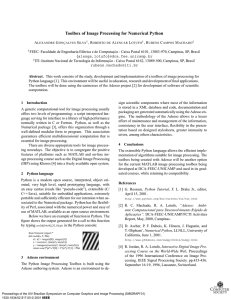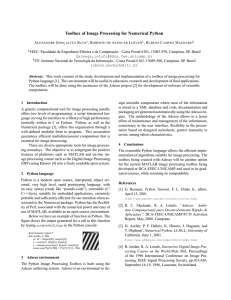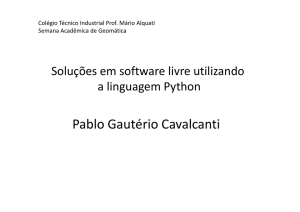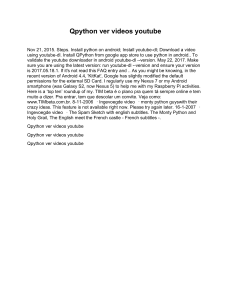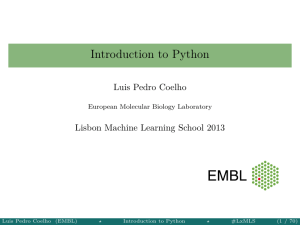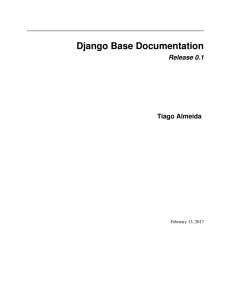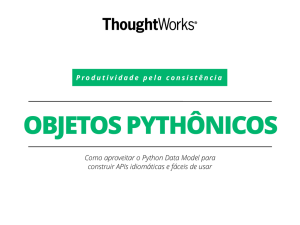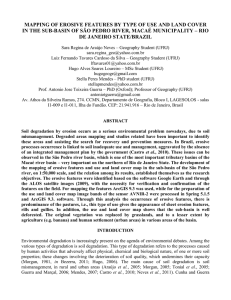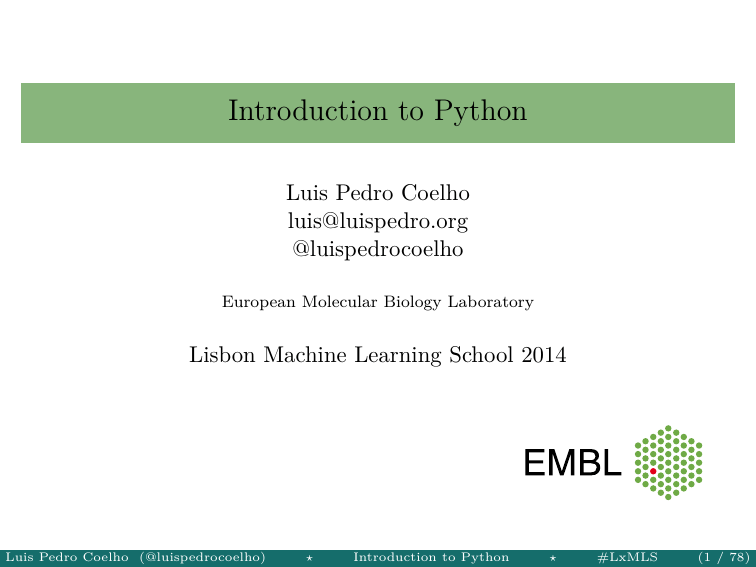
Introduction to Python
Luis Pedro Coelho
[email protected]
@luispedrocoelho
European Molecular Biology Laboratory
Lisbon Machine Learning School 2014
Luis Pedro Coelho (@luispedrocoelho)
⋆
Introduction to Python
⋆
#LxMLS
(1 / 78)
Today’s Lecture in Context
Today: basic introduction to Python & Numpy
During LxMLS, you will implement algorithms “by hand”
Tomorrow: scikit-learn by Andreas Mueller
Luis Pedro Coelho (@luispedrocoelho)
⋆
Introduction to Python
⋆
#LxMLS
(2 / 78)
Python Language History
Python was started in the late 80’s.
It was intended to be both easy to teach and industrial strength.
It is (has always been) open-source.
It has become one of the most widely used languages (top 10).
Luis Pedro Coelho (@luispedrocoelho)
⋆
Introduction to Python
⋆
#LxMLS
(3 / 78)
Popularity
Luis Pedro Coelho (@luispedrocoelho)
⋆
Introduction to Python
⋆
#LxMLS
(4 / 78)
Popularity
Luis Pedro Coelho (@luispedrocoelho)
⋆
Introduction to Python
⋆
#LxMLS
(5 / 78)
Python Versions
Python Versions
There are two major versions, currently: 2.7 and 3.4.
We are going to be using 2.7 (but 2.6 should be OK too).
Luis Pedro Coelho (@luispedrocoelho)
⋆
Introduction to Python
⋆
#LxMLS
(6 / 78)
Python Example
p r i n t ” H e l l o World ”
Luis Pedro Coelho (@luispedrocoelho)
⋆
Introduction to Python
⋆
#LxMLS
(7 / 78)
Task
Average
Compute the average of the following numbers:
1. 10
. 7
3. 22
2
. 14
5. 17
4
Luis Pedro Coelho (@luispedrocoelho)
⋆
Introduction to Python
⋆
#LxMLS
(8 / 78)
Python example
numbers = [ 10 , 7 , 22 , 14 , 17 ]
total = 0 . 0
n = 0.0
f o r v a l i n numbers :
total = total + val
n = n + 1
print total / n
Luis Pedro Coelho (@luispedrocoelho)
⋆
Introduction to Python
⋆
#LxMLS
(9 / 78)
“Python is executable pseudo-code.”
—Python lore (often attributed to Bruce Eckel)
Luis Pedro Coelho (@luispedrocoelho)
⋆
Introduction to Python
⋆
#LxMLS
(10 / 78)
Programming Basics
numbers = [ 10 , 7 , 22 , 14 , 17 ]
total = 0 . 0
n = 0.0
f o r v a l i n numbers :
total = total + val
n = n + 1
print total / n
Luis Pedro Coelho (@luispedrocoelho)
⋆
Introduction to Python
⋆
#LxMLS
(11 / 78)
Python Types
Basic Types
Numbers (integers and floating point)
Strings
Lists and tuples
Dictionaries
Luis Pedro Coelho (@luispedrocoelho)
⋆
Introduction to Python
⋆
#LxMLS
(12 / 78)
Python Types: Numbers I: Integers
A = 1
B = 2
C = 3
p r i n t A + B*C
Outputs 7.
Luis Pedro Coelho (@luispedrocoelho)
⋆
Introduction to Python
⋆
#LxMLS
(13 / 78)
Python Types: Numbers II: Floats
A = 1.2
B = 2.4
C = 3.6
p r i n t A + B*C
Outputs 9.84.
Luis Pedro Coelho (@luispedrocoelho)
⋆
Introduction to Python
⋆
#LxMLS
(14 / 78)
Python Types: Numbers III: Integers & Floats
A = 2
B = 2.5
C = 4.4
p r i n t A + B*C
Outputs 22.0.
Luis Pedro Coelho (@luispedrocoelho)
⋆
Introduction to Python
⋆
#LxMLS
(15 / 78)
Composite Assignment
total = total + n
Can be abbreviated as
t o t a l += n
Luis Pedro Coelho (@luispedrocoelho)
⋆
Introduction to Python
⋆
#LxMLS
(16 / 78)
Python Types: Strings
f i r s t = ’ John ’
l a s t = ”Doe”
full = first + ” ” + last
print f u l l
Luis Pedro Coelho (@luispedrocoelho)
⋆
Introduction to Python
⋆
#LxMLS
(17 / 78)
Python Types: Strings
f i r s t = ’ John ’
l a s t = ”Doe”
full = first + ” ” + last
print f u l l
Outputs John Doe.
Luis Pedro Coelho (@luispedrocoelho)
⋆
Introduction to Python
⋆
#LxMLS
(17 / 78)
Python Types: String Rules
What is a String Literal
Short string literals are delimited by (”) or (’).
Short string literals are one line only.
Special characters are input using escape sequences.
(\n for newline,…)
m u l t i p l e = ’ He : May I ?\ nShe : No , you may not . ’
a l t e r n a t i v e = ”He : May I ?\ nShe : No , you may not . ”
Luis Pedro Coelho (@luispedrocoelho)
⋆
Introduction to Python
⋆
#LxMLS
(18 / 78)
Python Types: Long Strings
We can input a long string using triple quotes (”’ or ”””) as delimiters.
l o n g = ’ ’ ’ T e l l me , i s l o v e
S t i l l a popular suggestion
Or merely an o b s o l e t e a r t ?
F o r g i v e me , f o r a s k i n g ,
This s i m p l e q u e s t i o n ,
I am u n f a m i l i a r with h i s h e a r t . ’ ’ ’
Luis Pedro Coelho (@luispedrocoelho)
⋆
Introduction to Python
⋆
#LxMLS
(19 / 78)
Python Types: Lists
c o u r s e s = [ ’ PfS ’ , ’ P o l i t i c a l P h i l o s o p h y ’ ]
p r i n t ”The t h e f i r s t c o u r s e i s ” , c o u r s e s [ 0 ]
p r i n t ”The s e c o n d c o u r s e i s ” , c o u r s e s [ 1 ]
Notice that list indices start at 0!
Luis Pedro Coelho (@luispedrocoelho)
⋆
Introduction to Python
⋆
#LxMLS
(20 / 78)
Python Types: Lists
mixed = [ ’ Banana ’ , 100 , [ ’ Another ’ , ’ L i s t ’ ] , [ ] ]
p r i n t l e n ( mixed )
Luis Pedro Coelho (@luispedrocoelho)
⋆
Introduction to Python
⋆
#LxMLS
(21 / 78)
Python Types: Lists
f r u i t s = [ ’ Banana ’ , ’ Apple ’ , ’ Orange ’ ]
fruits . sort ( )
print f r u i t s
Prints [’Apple’, ’Banana’, ’Orange’]
Luis Pedro Coelho (@luispedrocoelho)
⋆
Introduction to Python
⋆
#LxMLS
(22 / 78)
Python Types: Dictionaries
e m a i l s = { ’ L u i s ’ : ’ lpc@cmu . edu ’ ,
’ Mark ’ : ’ mark@cmu . edu ’ }
print ” Luis ’ s email i s ” , emails [ ’ Luis ’ ]
e m a i l s [ ’ Rita ’ ] = ’ rita@cmu . edu ’
Luis Pedro Coelho (@luispedrocoelho)
⋆
Introduction to Python
⋆
#LxMLS
(23 / 78)
Python Control Structures
s t u d e n t = ’ Rita ’
a v e r a g e = gradeavg ( s t u d e n t )
i f average > 0 . 7 :
p r i n t student , ’ passed ! ’
print ’ Congratulations ! ! ’
else :
p r i n t student , ’ f a i l e d . Sorry . ’
Luis Pedro Coelho (@luispedrocoelho)
⋆
Introduction to Python
⋆
#LxMLS
(24 / 78)
Python Blocks
Unlike almost all other modern programming languages,
Python uses indentation to delimit blocks!
i f <c o n d i t i o n>:
statement 1
statement 2
statement 3
next s t a t e m e n t
Luis Pedro Coelho (@luispedrocoelho)
⋆
Introduction to Python
⋆
#LxMLS
(25 / 78)
Convention
. Use 4 spaces to indent.
2. Other things will work, but confuse people.
1
Luis Pedro Coelho (@luispedrocoelho)
⋆
Introduction to Python
⋆
#LxMLS
(26 / 78)
Conditionals
Examples
x == y
x != y
x<y
x<y<z
x in lst
x not in lst
Luis Pedro Coelho (@luispedrocoelho)
⋆
Introduction to Python
⋆
#LxMLS
(27 / 78)
Nested Blocks
i f <c o n d i t i o n 1>:
do something
i f c o n d i t i o n 2>:
nested block
else :
nested e l s e block
e l i f <c o n d i t i o n 1b>:
do something
Luis Pedro Coelho (@luispedrocoelho)
⋆
Introduction to Python
⋆
#LxMLS
(28 / 78)
For loop
s t u d e n t s = [ ’ L u i s ’ , ’ Rita ’ , ’ Sabah ’ , ’ Mark ’ ]
for st in students :
print st
Luis Pedro Coelho (@luispedrocoelho)
⋆
Introduction to Python
⋆
#LxMLS
(29 / 78)
While Loop
w h i l e <c o n d i t i o n>:
statement1
statement2
Luis Pedro Coelho (@luispedrocoelho)
⋆
Introduction to Python
⋆
#LxMLS
(30 / 78)
Other Loopy Stuff
f o r i in range ( 5 ) :
print i
prints
0
1
2
3
4
This is because range(5) is the list [0,1,2,3,4].
Luis Pedro Coelho (@luispedrocoelho)
⋆
Introduction to Python
⋆
#LxMLS
(31 / 78)
Break
rita_enrolled = False
for st in students :
i f s t == ’ Rita ’ :
r i t a _ e n r o l l e d = True
break
Luis Pedro Coelho (@luispedrocoelho)
⋆
Introduction to Python
⋆
#LxMLS
(32 / 78)
Conditions & Booleans
Booleans
Just two values: True and False.
Comparisons return booleans (e.g., x < 2)
Conditions
When evaluating a condition, the condition is converted to a
boolean:
Many things are converted to False:
.
.
3.
4.
5.
1
2
[] (the empty list)
{} (the empty dictionary)
”” (the empty string)
0 or 0.0 (the value zero)
…
Everything else is True or not convertible to boolean.
Luis Pedro Coelho (@luispedrocoelho)
⋆
Introduction to Python
⋆
#LxMLS
(33 / 78)
Conditions Example
A
B
C
D
=
=
=
=
[]
[1,2]
2
0
i f A:
print
i f B:
print
i f C:
print
i f D:
print
’A i s t r u e ’
’B i s t r u e ’
’C i s t r u e ’
’D i s t r u e ’
Luis Pedro Coelho (@luispedrocoelho)
⋆
Introduction to Python
⋆
#LxMLS
(34 / 78)
Numbers
Two Types of Numbers
. Integers
2. Floating-point
1
Operations
. Unary Minus: -x
2. Addition: x + y
3. Subtraction: x - y
1
. Multiplication: x * y
5. Exponentiation: x ** y
4
Luis Pedro Coelho (@luispedrocoelho)
⋆
Introduction to Python
⋆
#LxMLS
(35 / 78)
Division
Division
What is 9 divided by 3?
What is 10 divided by 3?
Luis Pedro Coelho (@luispedrocoelho)
⋆
Introduction to Python
⋆
#LxMLS
(36 / 78)
Division
Division
What is 9 divided by 3?
What is 10 divided by 3?
Two types of division
. Integer division: x // y
2. Floating-point division: x / float(y)
1
Luis Pedro Coelho (@luispedrocoelho)
⋆
Introduction to Python
⋆
#LxMLS
(36 / 78)
Functions
def double ( x ) :
’’’
y = double ( x )
Returns t h e d o u b l e o f x
’’’
r e t u r n 2 *x
Luis Pedro Coelho (@luispedrocoelho)
⋆
Introduction to Python
⋆
#LxMLS
(37 / 78)
Functions
A=4
p r i n t d o u b l e (A)
p r i n t double ( 2 . 3 )
p r i n t d o u b l e ( d o u b l e (A) )
Luis Pedro Coelho (@luispedrocoelho)
⋆
Introduction to Python
⋆
#LxMLS
(38 / 78)
Functions II
d e f g r e e t ( name , g r e e t i n g= ’ H e l l o ’ ) :
p r i n t g r e e t i n g , name
g r e e t ( ’ Mario ’ )
g r e e t ( ’ Mario ’ , ’ Goodbye ’ )
Luis Pedro Coelho (@luispedrocoelho)
⋆
Introduction to Python
⋆
#LxMLS
(39 / 78)
Defining a class
Boat Class
We define a Boat class, with two values, latitude & longitude, and five
methods:
1. move_north, move_south, move_east, move_west
. distance
2
Luis Pedro Coelho (@luispedrocoelho)
⋆
Introduction to Python
⋆
#LxMLS
(40 / 78)
Defining & Calling Methods
Defining a method
c l a s s Boat ( o b j e c t ) :
d e f __init__ ( s e l f , l a t=0 , l o n g=0 ) :
self . latitude = lat
s e l f . longitude = long
d e f move_north ( s e l f , d l a t ) :
s e l f . l a t i t u d e += d l a t
Calling a Method
o b j = Boat ( )
o b j . method ( arg1 , a r g 2 )
Luis Pedro Coelho (@luispedrocoelho)
⋆
Introduction to Python
⋆
#LxMLS
(41 / 78)
Defining classes
c l a s s Boat ( o b j e c t ) :
d e f __init__ ( s e l f , l a t=0 , l o n g=0 ) :
self . latitude = lat
s e l f . longitude = long
d e f move_north ( s e l f , d l a t ) :
s e l f . l a t i t u d e += d l a t
__init__: special name (constructor)
self: the object itself (this in many other languages)
Instance variables are defined at first use
Luis Pedro Coelho (@luispedrocoelho)
⋆
Introduction to Python
⋆
#LxMLS
(42 / 78)
ScientificBoat
class ScientificBoat ( object ) :
d e f __init_ _( s e l f , l a t=0 , l o n g=0 ) :
self . latitude = lat
s e l f . longitude = long
d e f move_north ( s e l f , d l a t ) :
...
Luis Pedro Coelho (@luispedrocoelho)
⋆
Introduction to Python
⋆
#LxMLS
(43 / 78)
Numeric Python: Numpy
Numpy
Luis Pedro Coelho (@luispedrocoelho)
⋆
Introduction to Python
⋆
#LxMLS
(44 / 78)
Basic Type
numpy.array or numpy.ndarray.
Multi-dimensional array of numbers.
Luis Pedro Coelho (@luispedrocoelho)
⋆
Introduction to Python
⋆
#LxMLS
(45 / 78)
numpy example
import numpy a s np
A = np . a r r a y ( [
[0,1,2] ,
[2,3,4] ,
[4,5,6] ,
[6,7,8] ] )
p r i n t A[ 0 , 0 ]
p r i n t A[ 0 , 1 ]
p r i n t A[ 1 , 0 ]
Luis Pedro Coelho (@luispedrocoelho)
⋆
Introduction to Python
⋆
#LxMLS
(46 / 78)
numpy example
import numpy a s np
A = np . a r r a y ( [
[0,1,2] ,
[2,3,4] ,
[4,5,6] ,
[6,7,8] ] )
p r i n t A[ 0 , 0 ]
p r i n t A[ 0 , 1 ]
p r i n t A[ 1 , 0 ]
0
1
2
Luis Pedro Coelho (@luispedrocoelho)
⋆
Introduction to Python
⋆
#LxMLS
(46 / 78)
Why Numpy?
Why do we need numpy?
import numpy a s np
lst = [0. ,1. ,2. ,3. ]
a r r = np . a r r a y ( [ 0 . , 1 . , 2 . , 3 . ] )
Luis Pedro Coelho (@luispedrocoelho)
⋆
Introduction to Python
⋆
#LxMLS
(47 / 78)
A Python List of Numbers
.
float
float
float
float
0.0
1.0
2.0
3.0
Luis Pedro Coelho (@luispedrocoelho)
⋆
Introduction to Python
⋆
#LxMLS
(48 / 78)
A Numpy Array of Numbers
float 0.0
.
Luis Pedro Coelho (@luispedrocoelho)
⋆
1.0
2.0
3.0
Introduction to Python
⋆
#LxMLS
(49 / 78)
Numpy Arrays
Advantages
Less memory consumption
Faster
Work with (or write) code in other languages (C, C++, Fortran…)
Luis Pedro Coelho (@luispedrocoelho)
⋆
Introduction to Python
⋆
#LxMLS
(50 / 78)
Matrix-vector multiplication
A = np . a r r a y ( [
[1, 0, 0] ,
[0, 1, 0] ,
[0, 0, 1] ] )
v = np . a r r a y ( [ 1 , 5 , 2 ] )
p r i n t np . dot (A, v )
Luis Pedro Coelho (@luispedrocoelho)
⋆
Introduction to Python
⋆
#LxMLS
(51 / 78)
Matrix-vector multiplication
A = np . a r r a y ( [
[1, 0, 0] ,
[0, 1, 0] ,
[0, 0, 1] ] )
v = np . a r r a y ( [ 1 , 5 , 2 ] )
p r i n t np . dot (A, v )
[1 5 2]
Luis Pedro Coelho (@luispedrocoelho)
⋆
Introduction to Python
⋆
#LxMLS
(51 / 78)
Matrix-Matrix and Dot Products
(
1 1
1 −1
Luis Pedro Coelho (@luispedrocoelho)
)(
⋆
0 1
1 0
)
(
=
1 1
−1 1
Introduction to Python
)
⋆
#LxMLS
(52 / 78)
Matrix-Matrix and Dot Products
(
1 2
)
(
·
3
−1
)
= 1 · 3 + (−1) · 2 = 1.
This is a vector inner product (aka dot product)
< ⃗x, ⃗y >= ⃗x · ⃗y = ⃗xT⃗y.
Luis Pedro Coelho (@luispedrocoelho)
⋆
Introduction to Python
⋆
#LxMLS
(53 / 78)
v0 = np . a r r a y ( [ 1 , 2 ] )
v1 = np . a r r a y ( [ 3 , - 1 ] )
r = 0.0
f o r i i n xrange ( 2 ) :
r += v0 [ i ] * v1 [ i ]
print r
p r i n t np . dot ( v0 , v1 )
Luis Pedro Coelho (@luispedrocoelho)
⋆
Introduction to Python
⋆
#LxMLS
(54 / 78)
A0 = np . a r r a y ( [ [ 1 , 2 ] , [ 2 , 3 ] ] )
A1 = np . a r r a y ( [ [ 0 , 1 ] , [ 1 , 0 ] ] )
p r i n t np . dot (A0 , A1)
Luis Pedro Coelho (@luispedrocoelho)
(
0 2
2 3
⋆
)(
0 1
1 0
)
Introduction to Python
⋆
#LxMLS
(55 / 78)
Some Array Properties
import numpy a s np
A = np . a r r a y ( [
[0,1,2] ,
[2,3,4] ,
[4,5,6] ,
[6,7,8] ] )
p r i n t A. shape
p r i n t A. s i z e
Luis Pedro Coelho (@luispedrocoelho)
⋆
Introduction to Python
⋆
#LxMLS
(56 / 78)
Some Array Functions
...
p r i n t A. max( )
p r i n t A. min ( )
max(): maximum
min(): minimum
ptp(): spread (max - min)
sum(): sum
std(): standard deviation
…
Luis Pedro Coelho (@luispedrocoelho)
⋆
Introduction to Python
⋆
#LxMLS
(57 / 78)
Other Functions
np.exp
np.sin
…
All of these work element-wise!
Luis Pedro Coelho (@luispedrocoelho)
⋆
Introduction to Python
⋆
#LxMLS
(58 / 78)
Arithmetic Operations
import numpy a s np
A = np . a r r a y ( [ 0 , 1 , 2 , 3 ] )
B = np . a r r a y ( [ 1 , 1 , 2 , 2 ] )
print A + B
print A * B
print A / B
Luis Pedro Coelho (@luispedrocoelho)
⋆
Introduction to Python
⋆
#LxMLS
(59 / 78)
Arithmetic Operations
import numpy a s np
A = np . a r r a y ( [ 0 , 1 , 2 , 3 ] )
B = np . a r r a y ( [ 1 , 1 , 2 , 2 ] )
print A + B
print A * B
print A / B
[1 2 4 5]
[0 1 4 6]
[0 1 1 1]
Luis Pedro Coelho (@luispedrocoelho)
⋆
Introduction to Python
⋆
#LxMLS
(59 / 78)
Numpy Dtypes
All members of an array have the same type
Either integer or floating point
Defined when you first create the array
A = np . a r r a y ( [ 0 , 1 , 2 ] )
B = np . a r r a y ( [ 0 . 5 , 1 . 1 , 2 . 1 ] )
A *= 2 . 5
B *= 2 . 5
print A
print B
[0 2 5]
[ 1.25 2.75 5.25]
Luis Pedro Coelho (@luispedrocoelho)
⋆
Introduction to Python
⋆
#LxMLS
(60 / 78)
A = np . a r r a y ( [ 0 , 1 , 2 ] , dtype=np . i n t 1 6 )
B = np . a r r a y ( [ 0 , 1 , 2 ] , dtype=np . f l o a t 3 2 )
np.int8, np.int16, np.int32
np.uint8, np.uint16, np.uint32
np.float32, np.float64
np.bool
Luis Pedro Coelho (@luispedrocoelho)
⋆
Introduction to Python
⋆
#LxMLS
(61 / 78)
Object Construction
import numpy a s np
A = np . a r r a y ( [ 0 , 1 , 1 ] , np . f l o a t 3 2 )
A = np . a r r a y ( [ 0 , 1 , 1 ] , f l o a t )
A = np . a r r a y ( [ 0 , 1 , 1 ] , b o o l )
Luis Pedro Coelho (@luispedrocoelho)
⋆
Introduction to Python
⋆
#LxMLS
(62 / 78)
Reduction
A = np . a r r a y ( [
[0,0,1] ,
[1,2,3] ,
[2,4,2] ,
[1,0,1] ] )
p r i n t A. max( 0 )
p r i n t A. max( 1 )
p r i n t A. max( )
prints
[2,4,3]
[1,3,4,1]
4
The same is true for many other functions.
Luis Pedro Coelho (@luispedrocoelho)
⋆
Introduction to Python
⋆
#LxMLS
(63 / 78)
Slicing
import numpy a s np
A = np . a r r a y ( [
[0,1,2] ,
[2,3,4] ,
[4,5,6] ,
[6,7,8] ] )
p r i n t A[ 0 ]
p r i n t A[ 0 ] . shape
p r i n t A[ 1 ]
p r i n t A[ : , 2 ]
Luis Pedro Coelho (@luispedrocoelho)
⋆
Introduction to Python
⋆
#LxMLS
(64 / 78)
Slicing
import numpy a s np
A = np . a r r a y ( [
[0,1,2] ,
[2,3,4] ,
[4,5,6] ,
[6,7,8] ] )
p r i n t A[ 0 ]
p r i n t A[ 0 ] . shape
p r i n t A[ 1 ]
p r i n t A[ : , 2 ]
[0, 1, 2]
(3,)
[2, 3, 4]
[2, 4, 6, 8]
Luis Pedro Coelho (@luispedrocoelho)
⋆
Introduction to Python
⋆
#LxMLS
(64 / 78)
Slices Share Memory!
import numpy a s np
A = np . a r r a y ( [
[0,1,2] ,
[2,3,4] ,
[4,5,6] ,
[6,7,8] ] )
B = A[ 0 ]
B[ 0 ] = - 1
p r i n t A[ 0 , 0 ]
Luis Pedro Coelho (@luispedrocoelho)
⋆
Introduction to Python
⋆
#LxMLS
(65 / 78)
Pass is By Reference
d e f d o u b l e (A) :
A *= 2
A = np . a r a n g e ( 20 )
d o u b l e (A)
Luis Pedro Coelho (@luispedrocoelho)
⋆
Introduction to Python
⋆
#LxMLS
(66 / 78)
Pass is By Reference
d e f d o u b l e (A) :
A *= 2
A = np . a r a n g e ( 20 )
d o u b l e (A)
A = np . a r a n g e ( 20 )
B = A. copy ( )
Luis Pedro Coelho (@luispedrocoelho)
⋆
Introduction to Python
⋆
#LxMLS
(66 / 78)
Logical Arrays
A = np . a r r a y ( [ - 1 , 0 , 1 , 2 , - 2 , 3 , 4 , - 2 ] )
p r i n t (A > 0 )
Luis Pedro Coelho (@luispedrocoelho)
⋆
Introduction to Python
⋆
#LxMLS
(67 / 78)
Logical Arrays II
A = np . a r r a y ( [ - 1 , 0 , 1 , 2 , - 2 , 3 , 4 , - 2 ] )
p r i n t ( (A > 0 ) & (A < 3 ) ) . mean ( )
What does this do?
Luis Pedro Coelho (@luispedrocoelho)
⋆
Introduction to Python
⋆
#LxMLS
(68 / 78)
Logical Indexing
A[A < 0 ] = 0
or
A *= (A > 0 )
Luis Pedro Coelho (@luispedrocoelho)
⋆
Introduction to Python
⋆
#LxMLS
(69 / 78)
Logical Indexing
p r i n t ’ Mean o f p o s i t i v e s ’ , A[A > 0 ] . mean ( )
Luis Pedro Coelho (@luispedrocoelho)
⋆
Introduction to Python
⋆
#LxMLS
(70 / 78)
Some Helper Functions
Constructing Arrays
A = np . z e r o s ( ( 10 , 10 ) , dtype=np . i n t 8 )
B = np . o n e s ( 10 )
C = np . a r a n g e ( 100 ) . r e s h a p e ( ( 10 , 10 ) )
...
Multiple Dimensions
img = np . z e r o s ( ( 1024 , 1024 , 3 ) , dype=np . u i n t 8 )
Luis Pedro Coelho (@luispedrocoelho)
⋆
Introduction to Python
⋆
#LxMLS
(71 / 78)
Documentation
http://docs.scipy.org/doc/
Luis Pedro Coelho (@luispedrocoelho)
⋆
Introduction to Python
⋆
#LxMLS
(72 / 78)
Last Section
Matplotlib & Spyder
Luis Pedro Coelho (@luispedrocoelho)
⋆
Introduction to Python
⋆
#LxMLS
(73 / 78)
Matplotlib
Matplotlib is a plotting library.
Very flexible.
Very active project.
Luis Pedro Coelho (@luispedrocoelho)
⋆
Introduction to Python
⋆
#LxMLS
(74 / 78)
Example I
import numpy a s np
import m a t p l o t l i b . p y p l o t a s p l t
X = np . l i n s p a c e ( - 4 , 4 , 1000 )
p l t . p l o t (X, X* * 2*np . c o s (X* * 2 ) )
p l t . s a v e f i g ( ’ s i m p l e . pdf ’ )
( )
y = x2 cos x2
Luis Pedro Coelho (@luispedrocoelho)
⋆
Introduction to Python
⋆
#LxMLS
(75 / 78)
Example I
15
10
5
0
5
10
15
20 4
3
Luis Pedro Coelho (@luispedrocoelho)
1
2
⋆
0
1
2
Introduction to Python
3
⋆
4
#LxMLS
(76 / 78)
Resources
Numpy+scipy docs: http://docs.scipy.org
Matplotlib: http://matplotlib.sf.net
Python docs: http://docs.python.org
These slides are available at http://luispedro.org/talks/2014
I’m available at [email protected]
@luispedrocoelho on twitter
Luis Pedro Coelho (@luispedrocoelho)
⋆
Introduction to Python
⋆
#LxMLS
(77 / 78)
Thank you.
Luis Pedro Coelho (@luispedrocoelho)
⋆
Introduction to Python
⋆
#LxMLS
(78 / 78)

